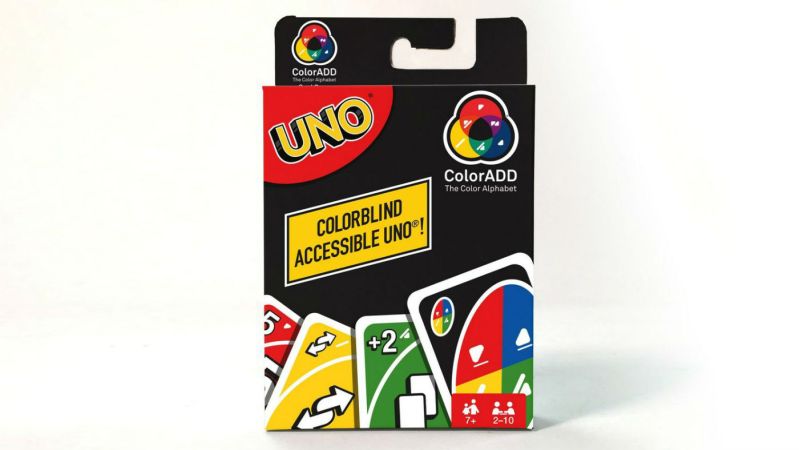A riddle: What do Prince William, Keanu Reeves, Mark Zuckerberg and 8 percent of men in the world have in common? They’re all color blind. Uno, the No. 1 one card game in our childhood hearts and the world over, has released a special edition specifically for people with color blindness in honor of International Color Blindness Awareness Day on September 6.
Color blindness is the result of missing or non-functioning cone cells in the retina. Quick human anatomy lesson: Rods detect light and darkness and cones detect color. More specifically, there are three types of cones that detect red, green, and blue. Severe color blindness stems from a lack of all three cones, whereas a mild version has all cones present but one is malfunctioning. Men are far more likely than women to have the condition — about one in 12 men are color blind. There’s no cure for the congenital form of color blindness (as opposed to the side effect of certain drugs or conditions), but there are expensive contacts and glasses than can help.
Sadly, 42 percent of color blind people have reported feeling a certain level of difficulty in social situations. Just imagine if you’re invited to sit down and play a lively game of Uno with LeBron James and Chris Paul or your best buds on the Atlanta Hawks, but you can’t tell the colors apart. You might hesitate to accept CP3’s offer to play and then you’d lose out on a dinner party story destined to never be one-upped. Even if you’re playing with non-famous friends, an otherwise simple act becomes an intimidating prospect.
So, Uno teamed up with the people behind ColorADD, a revolutionary color identification system that’s already been implemented widely in places like Brazil and Portugal’s public transit, hospitals, and schools. The United Nations thought so highly of the system they honored it as one of the “54 best practices at world level regarding innovation and accessibilities.” No small praise.

ColorADD uses five symbols to represent the primary colors: blue, yellow, and red, as well as black and white. A combination of these symbols represents secondary colors, like green, orange, and purple. Combine a secondary color symbol and a primary color symbol, and baby, you’ve got tertiary colors like turquoise or indigo. Light and dark grey get their own symbols, and parenthesis before the symbol notes that it’s gold or silver. The ColorADD system can even denote how dark or light a tone is.
Uno combined these easy-to-learn symbols with the classic cards to create the Uno ColorADD pack. “Our partnership with ColorADD allows us to extend the game play to the 350 million people globally and 13 million Americans who are colorblind,” says Ray Adler, senior director of global games at Mattel. “Uno is a truly universal game and we are continuing to look for ways to make one of the world’s most popular card games all inclusive.”
Mattel is keeping the good deeds rolling just in time for October’s Breast Cancer Awareness month. Uno is also partnering with the Susan G. Komen Foundation for the pink pack. Available at Walgreens, a portion of the proceeds from these packs goes directly to breast cancer research.
Uno ColorADD packs are available through the Mattel website for $6 — a ridiculously small price to help people feel more included. Just be sure to carry it with you at all times in case basketball legends randomly ask you to play.


